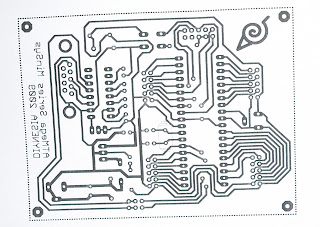After a few hours of frantic googling and running to the local components store, I had all I needed. I had a feeling that this was not gonna be short and sweet, so I thought I'd document the whole thing. So here goes:
The first step was to design the board. This proved to be quite easy, considering that aligning things was as simple as a click and drag, and erasing your mistakes was as simple as Ctrl+Z.
Once this was done, the next step was to print it out. I was actually supposed to print it out in a laser printer, but since I have an inkjet and I'm usually a stickler for saving money, I opted for printing out and then taking xeroxes of the whole thing.
After getting the design on paper, what remained was to transfer it to the copper-clad board. The essential idea was that the toner would stick to the copper and prevent it from being etched off by the etching solution.
Now we immerse the board in the etching solution, which is basically a solution of Ferric Chloride in water.
Now comes the hardest part: waiting. In all but the last phase of etching, there is no visible change, so you keep stirring the solution and waiting for something to happen...
After a while, I was so tired of waiting that I fashioned a makeshift stirrer out of an old motor and a potentiometer I had lying around. Turns out that the spindle for the motor was made of copper, so guess what happened...
FINALLY. Parts of wood started to show in between the tracks, meaning that most of the copper had already dissolved.
After another hour or so, the board was finally completed.
Here are the copper tracks left after sanding off the toner:
Now all that's left are simple yet time-consuming jobs, such as drilling holes in the PCB and attaching the necessary components. Here goes:
Both of them have the same circuits, yet you can clearly see the difference in size and complexity. Believe me, when I started out I had no expectation of getting it this far. Amazing, isn't it?







